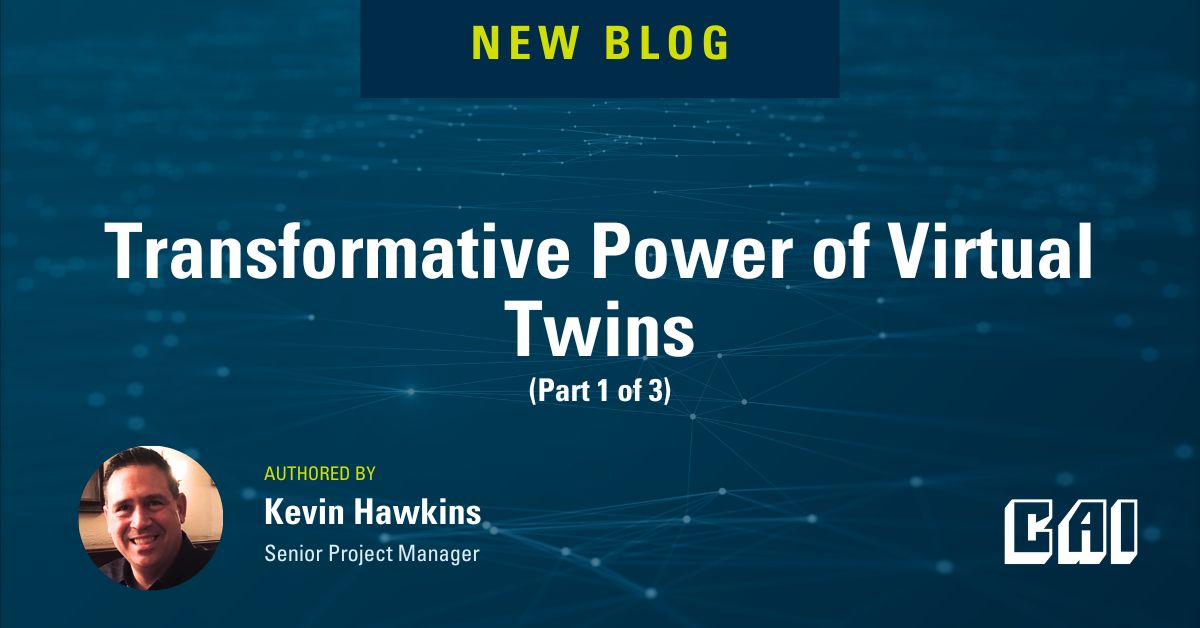
Transformative Power of Virtual Twins (Part 1 of 3)
This is the first installment of a three-part series exploring the transformative power of Virtual Twins when applied to an asset induction effort for facility maintenance. The information in this series is based on the use of Virtual Twin technology for a biomanufacturing site, but the same principles could be applied to any facility that is looking to leverage a digital twin for their facility.
Part One – The Challenge: How to leverage Virtual Twins for efficient Asset Induction in a Complex Facility Environment.
Introduction:
In today’s fast-paced and technologically advanced world, industries are constantly seeking innovative solutions to streamline their operations. One such groundbreaking technology that has gained prominence in recent years is Virtual Twins. This blog explores the application of Virtual Twins in the context of asset induction for a large-scale effort involving 6,000 asset records spread across seven buildings, totaling 500,000 square feet of facilities.
What are Virtual Twins?
Virtual Twins are digital replicas of physical objects or systems. These digital representations mimic the real-world entities in every aspect, providing a comprehensive understanding of their behavior, performance, and interactions. In the realm of asset management, Virtual Twins offer a powerful tool to optimize processes and enhance efficiency.
Asset Induction Challenges in a Complex Facility Environment:
Managing a project with a diverse array of assets across multiple buildings poses several challenges. Traditional asset induction processes can be time-consuming, error-prone, and resource-intensive. Leveraging Virtual Twins can address these challenges by providing a virtual environment for planning, simulation, and execution of asset induction efforts with shorter implementation time, reduced budget, and higher quality product with less required re-work.
The key benefit for using Virtual Twins in an asset induction effort is that it offers an in-depth understanding of assets, aiding in their configuration, operation, and maintenance. It can facilitate practical training sessions for the end users, simulating various operational scenarios. In addition, it can allow for predictive maintenance, helping to minimize downtime and extend the lifecycle of assets through proactive measures. This enables collaboration among teams, aiding in informed decision-making and streamlined operations. This in turn facilitates an accelerated commissioning process by enabling virtual testing and validation, leading to smoother deployment.
Additional benefits were realized or quantified through:
Visualization and Simulation:
- This approach was used to gain a holistic view of the entire campus of seven facilities and their assets through immersive visualizations.
- The induction process was simulated to identify potential challenges and optimize workflows before implementation.
Data Accuracy and Consistency:
- Accurate and consistent asset information was ensured by synchronizing virtual and physical data.
- Errors associated with manual data entry were minimized through automated updates.
Remote Monitoring and Control:
- Remote monitoring of the asset induction process enabled real-time decision-making.
- This also enabled control and adjustment of workflows as needed, improving adaptability to changing circumstances.
Collaboration and Communication:
- By providing a shared virtual environment, the use of Virtual Twins facilitated collaboration among teams.
- Visual representations enhanced communication, reducing misunderstandings and errors.
Implementation steps for a 6,000 Asset Record Induction:
Data Integration:
- Integrate existing asset records into the Virtual Twin environment.
- Validate and clean data to ensure accuracy and completeness.
Virtual Planning:
- Plan the asset induction process within the virtual environment, considering building layouts and logistics.
- Simulate different scenarios to optimize the workflow.
Automated Updates:
- Establish automated mechanisms for updating virtual and physical asset data in real-time.
- Ensure consistency between the digital twin and the actual assets.
Training and Familiarization:
- Use the Virtual Twin for training purposes, allowing personnel to familiarize themselves with the induction process.
- Reduce on-site learning curves and minimize errors during actual implementation.
Continuous Monitoring and Improvement:
- Implement monitoring tools to track the progress of the asset induction in real-time.
- Gather feedback and data for continuous improvement of the process.
Conclusion:
Leveraging Virtual Twins for asset induction in a complex facility environment offers a transformative approach to enhance efficiency, accuracy, and collaboration. As industries embrace digitalization, the integration of Virtual Twins into asset management practices becomes a strategic imperative.
Part One of this series provided an overview of implementation of this technology and benefits once completed. In Part Two we will address the process of capturing and modeling data to build the Virtual Twin, and the Project Management tools used to ensure all required deliverables were accomplished. And Part Three will focus on project management aspects and benefits realized through Virtual Twin implementation including examples of effective outcomes in projects completed by CAI.
Tags: digital transformation, asset management, reliability, maintenance, virtual twin, computerized maintenance


